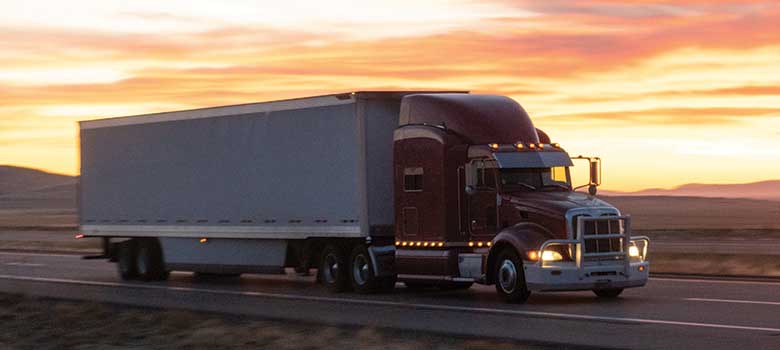Truckload Update: Making their way through the haze
Rapidly diversifying truckload carriers are riding out a slump in long-haul ground freight. These “durable, diversified, and resilient” plans are paying off for those TL carriers willing to change with the economic headwinds facing the sector.
The $403 billion full truckload (TL) market is trucking’s largest sector, and it’s on the downward slide of the biggest roller-coaster ride in the overall $896 billion trucking industry.
Starting in 2018, truckload carriers overcame the tight market for qualified drivers and posted some of the healthiest margins in the industry due to capacity constraints at the time. The following year was so-so, followed by the COVID shutdown of 2020 and then the recovery in 2021. That was followed by a boom recovery year of 2022, when trucking demand exceeded capacity—and rates skyrocketed.
All of this has led us to the slump of 2023 that has seen thousands of operators exit from the TL market. Mainly, the exodus from the market has been owner-operators and those carriers playing the spot market, which has seen double-digit drops in rates this year.
Tens of thousands of owner-operators—lured into the market by record high spot rates during the COVID boom year of 2022—have left the marketplace. Federal government data show that there’s been a reduction in authorized American truckers—mostly owner-operators, but not all—for 51 straight weeks, as of Oct. 1.
That’s occurred because of overall reduction in long-haul, over-the-road ground freight, shortages of qualified drivers and, most recently, a sharp mid-year rise in diesel prices, which rose a staggering 32 cents a gallon during one two-week stretch in mid-summer.
Avery Vise, vice president of trucking for research firm FTR, says that he’s issuing a forecast for 2024 spot and contract rates that’s “markedly different” from 2023. For shippers, that means the bargain days of cut-rate spot and contract rates could be over.
“There was an unprecedented surge in activity from late 2020 through 2022,” says Vise. “The shift backward from that level has kept capacity at high levels—almost record levels. That has fueled no rate strength, it’s just stagnant. Loss of capacity has had no effect, and everything is in status quo environment.”

Carrier executives in the TL sector say that they’re “cautiously optimistic” about 2024 rates. After a first lackluster half of the year, they endured headwinds in the third quarter, which is usually the peak season for ground transport in the United States.
Most TL executives contacted for this story said they were hoping—finally, after three years of bust-boom-bust cycles after the pandemic shutdown and its resulting surge in traffic—for a somewhat measured return to normalcy.
However, they still see some difficult remaining headwinds—the national economy, driver shortage, increases in costs for everything from trucks to fuel to insurance to driver pay—as they cautiously enter 2024.
Darren Field, J.B. Hunt vice president and head of its intermodal operations, put it very succinctly at a recent investor conference in New York: “I don’t have any customers really predicting a significant peak season. So, we’re not hearing about needs for capacity in an elevated manner for the holiday shopping season.”
As we approach the end of 2023, let’s take a deeper dive into how carriers are diversifying their revenue base; what’s happening with the driver shortage and excess truck capacity from bankruptcies; and we’ll take a peek into forecasts for 2024 TL rates, both contract and spot market.
Diversify or die
The most enlightened truckload companies are hardly waiting around for the basic market for 53-foot dry van TL traffic to rebound. Instead, they’re acting on corporate diversification strategies hatched years—if not decades—earlier, to insulate themselves from the cyclical vagaries of the long-haul, dry van market.
Werner, the nation’s 6th-largest TL carrier, suffered a 59% drop in net income in the second quarter and a 48% drop in net in the first half of this year, compared with year-ago figures.
While macroeconomic conditions and contnuined softness in the freight market remained in what Werner chairman, president and CEO Derek Leathers called “challenging” in the first half of the year, it still managed to increase total revenue net of fuel surcharges year-over-year. That’s because Werner’s logistics segment grew for the 11th straight quarter, and its dedicated business remained steady with continued revenue-per-truck growth.
Werner’s logistics unit grew 10% in the second quarter year over year as its revenue hit $224.5 million. “We’re progressing in our cost savings program with moderating expense trends emerging,” says Leathers, calling its diversified business model “durable, diversified and resilient.”
It can be seen in the numbers. While Werner suffered a $25.2 million decline in total revenue for the second quarter (due to a $43.4 million decline in truckload revenue, mostly due to a $42 million decline in fuel surcharges), that was partially offset by growth in its logistics sector. Logistics revenue grew 10% to $20.7 million.
“We have a powerful business model,” adds Leathers, referring to how it deploys its 8,300 trucks. “We have a large and durable dedicated fleet, a diversified one-way truckload fleet and a growing logistics segment. Our approach has created clear competitive advantages that will continue to fuel our growth, durability and earnings.”
“I don’t have any customers really predicting a significant peak season. So, we’re not hearing about needs for capacity in an elevated manner for the holiday shopping season.”
Transport, Inc. (Texarkana, Ark.), Star Transportation Inc. (La Vergne, Tenn.) and Landair Transportation, Inc. (Greeneville, Tenn.).
At Covenant, combined truckload business revenue decreased 15.2% to $185.3 million from $218.4 million during the 2022 second quarter. Operating Income decreased 48.2% to $9.06 million from $17.5 million. The carrier’s president and COO Paul Bunn recently called the current TL freight environment “challenging.” However, with significant capacity exiting the marketplace during the summer months, he believes TL freight demand is heading toward better equilibrium in 2024.
Yellow’s effect on the hunt for drivers, capacity
Yellow Corp., the 3rd-largest less-than-truckload (LTL) carrier, ceased operations in early August. That idled 24,000 workers, including about 13,000 fully qualified, experienced drivers.
While it’s still early, Yellow’s demise seems to have had little effect on hiring in the TL sector. That’s because unionized pay in the LTL sector—cited by analysts as a major piece in Yellow’s cessation on Aug. 7—is much higher, especially compared to TL driver pay.
Rest and meal breaks a concern
How to mandate rest and meal breaks has been a contentious issue among truckload fleets ever since California determined in 2018 that it would consider petitions for waivers from the Federal Motor Carrier Safety Administration’s (FMCSA) regulations.
At issue is the agency rules that were preempted with respect to commercial drivers subject to federal hours-of-service regulations. In response, ATA president and CEO Chris Spear blasted FMCSA’s action, saying a “patchwork” of state rules cannot work in interstate commerce.
“Ensuring a singular, national standard of work rules for professional drivers is crucial to both safety and the supply chain,” Spear says. “Congress first addressed this issue decades ago… and the Department of Transportation’s authority to pre-empt state rules was unanimously reaffirmed in a 2021 ruling by the U.S. Court of Appeals for the Ninth Circuit.”
According to Spear, federal law already mandates rest breaks for drivers. Spear adds. “Unnecessary and duplicative state laws are not grounded in safety and have been primarily enforced via private lawsuits designed to extort the trucking industry.”
Opening the door to this spurious litigation once again would impair the safe and efficient movement of interstate goods, Spear says. “ATA is fully prepared to oppose this effort that would result in a confusing patchwork of regulations.”
Yellow’s used trucks may cause more of a market factor than its former drivers, analysts predict. Yellow owned roughly 14,000 trucks, many of which were day-cabs used in local pickup and delivery. The sleepers in Yellow’s inventory, however, are likely very desirable.
Yellow had an aging fleet, but did buy about 2,000 new Class 8 cabs in model years 2022 and 2023, partially because of the $700 million government loan arranged during the waning days of the Trump administration. Most or all of these newer trucks should be absorbed by other fleets without much impact to values in the used truck market, analysts say.
Indianapolis-based Celadon—another major truckload bankruptcy—had around 2,800 trucks when it closed in late 2019. Those hit the used truck market in mid-2020, coinciding with the start of the pandemic bubble in used truck prices.
The drop off in pandemic-related truckload demand probably masked any downward pressure on values from the wave of bankruptcies in 2019-2020, analysts say. Yellow’s inventory will be liquidated into the used truck market that’s just starting to get back to normal after the post-pandemic correction. So, that recovery could be somewhat prolonged or delayed because of the sheer number of Yellow’s used trucks on the market.
What about rates?
This is where the rubber meets the road for shippers who often view truckload freight as a commodity. For all the talk about capacity, total logistics solutions, and reliable availability of equipment, many shippers simply opt for the lowest rate in truckload freight.
In 2024, that capacity will cost more. FTR is predicting incremental increases of 7% for spot TL rates, and a 1% drop for contract freight. By comparison, overall spot rates for all of 2023 were down 18% year over year while contract rates fell 7%.
“That’s not particularly robust,” says FTR’s Vise. “But don’t forget that TL contract rates were down 7% in 2023, and we’re entering 2024 at a considerably lower level than 2023 levels.”
FTR is expecting 2024 to be a “positive year,” mainly because spot rates were so weak during 2023. As of press time, contract rates in the TL market had not bottomed out. “We’re starting 2024 in significant negative territory,” adds Vise. “Contract rates move slowly. We’ll start seeing them come around next summer.”
Werner’s Leathers thinks retail “de-stocking” will abate early next year. “We remain cautious about consumer behavior, given mixed data points and themes impacting spending,” he says. “Particularly for goods and services.”
Many factors have caused a recession in freight, including sluggish spending on goods by households as consumers traveled more and bought less. Additionally, less home construction, falling factory output and shippers consolidating freight into fewer shipments all factored into the truckload slump of 2023.
Some of those factors will linger into 2024 before an expected rebound the latter half of next year, analysts say. “The big takeaway for TL carriers is that 2024 is not really a boom-and-bust year,” Vise predicts. “I’m not so sure the big boom is coming, at least before 2025.”













